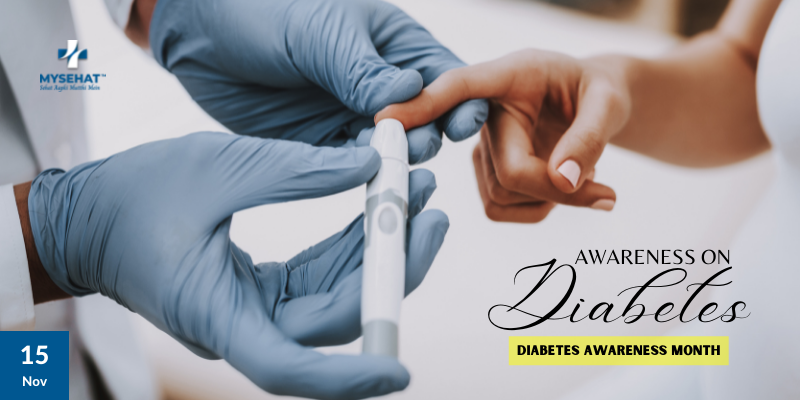(Awareness) Diabetes is one of the most commonly occurring conditions that happen to people. Even after having thousands of cases of diabetes every year people are unaware of the factors that come along with it. All types of diabetes need to monitor very carefully to get going. Some medical facts need to be considered if you know someone who is suffering from this problem or a person who needs treatment. For allowing better prevention and management of this condition, here are some facts that you need to know about.
Diabetes is a chronic disease with no cure
Many people believe that once diabetes develops, it cannot be cured. Some people also believe that it gets worse over time. However, the fact remains that there is no specific treatment for type 2 diabetes. Doctors explain that diabetes is a condition that can be controlled and reduced with timely and appropriate preventive measures. In a single state, if insulin and hormone levels are not used, cells can become resistant to insulin.
Insulin is one of the main factors supporting body function in diabetes. The function of insulin is to regulate metabolism and glucose to increase blood sugar levels. As part of cellular resistance, various cells prevent insulin from functioning properly, raising blood sugar levels in the body.
For some people, it poses a higher risk
People don’t know that diabetes can affect some people more than others. It depends on living conditions, family history, and hormonal changes in the body. Diabetes is a disease that can be transmitted to older generations or people living in certain parts of the world.
Some risk factors that increase your tendency to diabetes are overweight who has the most fat in the abdomen family history of diabetes history of gestational diabetes All family members have a history of prediabetes. No activity or less exercise than necessary 45+, People with diseases such as low HDL cholesterol, high triglycerides, and high blood pressure.
Diabetes is now more common among young people
Diabetes and blood sugar problems have been more common among older people over the past decade, but now the scenario is changing. Due to unhealthy foods and irregular diets, people develop diabetes at a very young age, which also threatens the health of future generations. According to a study by the World Health Organization (WHO), it is more likely to be diagnosed in younger people, with a 23% increase in those under 40. This had to do with people’s BMI levels. Unhealthy eating habits and food tampering make it difficult to even eat healthy food.
One example is fresh vegetables. Injections are made to grow a variety of vegetables and are mainly hormones that cause great harm to human health.
Diabetes can be controlled by a few changes
One of the important things to know about diabetes is that it is easy to manage with lifestyle changes. Exercise is essential for diabetics and creates a balance between blood sugar and metabolic rate. Diabetes can be reduced and controlled to normal levels just like anyone without diabetes.
Lifestyle changes must happen in a way that follows these things. Maintaining a healthy weight 30 minutes of regular exercise can help limit sugar and beverages to almost negligible levels avoid all forms of tobacco use blood sugar control.
Diabetes can go unnoticed for years
There is a misconception that people with diabetes will notice within a few weeks. But this is not true. It has been medically confirmed that people with diabetes may go unnoticed for the first few years. This is because insulin and blood sugar levels do not rise to problematic or symptomatic levels. It is important to be very careful with high blood sugar levels and to know that you should have a medical checkup once a month to monitor your health parameters.
Leads to serious complications
It is medically approved and people are known to have serious complications and disabilities from diabetes. Although both types of diabetes have different complications, they can develop and cause serious problems, including stroke, heart failure, kidney failure, and Alzheimer’s disease. Health complications can be prevented by carefully observing the following: blood-sugar-cholesterol level, blood pressure, regular exercise, lifestyle change, regular health check-up.
Facts on Diabetes
- Diabetes history:
Diabetes is an old disease, and ancient Egyptian manuscripts date back to 1500 BC. Diabetes is referred to as a disease characterized by urinating too much. Indian doctors call it manumea (honey urine) because diabetic urine attracts ants.
- Diabetes – the name was coined:
Diabetes (Latin “Sweet as Honey”) was coined in 1798 by the British surgeon John Rollo to distinguish this diabetes from other diabetes mellitus (diabetes insipidus) in which the urine is tasteless. It was a way of diagnosing diabetes before chemical tests and test strips became mainstream methods of recognizing diabetes. Thomas Willis, a London physician, actually began in the 17th century by tasting the urine of his patients to see if the urine was honey.
- World Diabetes Day, November 14:
World Diabetes Day was established in 1991 by the International Diabetes Federation (IDF) and the World Health Organization (WHO) in response to growing concerns about the growing health threat posed by diabetes. This day is celebrated annually on November 14, the birthday of Sir Frederick Banting, who discovered insulin with Charles Best in 1922.
- Prediabetes:
Prediabetes is an impaired glucose tolerance and is considered a serious medical condition in which blood sugar levels are higher than normal but not high enough to be diagnosed as type 2 diabetes. People are often unaware that they have diabetes, which is more common in prediabetes.
- Types of diabetes:
There are three types of diabetes: type 1, type 2, and gestation:
Type 1 diabetes is an autoimmune disease in which the body is unable to produce insulin and is dependent on an external source of insulin. It usually affects children and adolescents, but may appear later. Type 1 diabetes is also called insulin-dependent diabetes.
Type 2 diabetes was formerly called insulin-dependent diabetes mellitus or adult diabetes. About 90% of people with diabetes have type 2 diabetes. In type 2 diabetes, insulin production is low or the body does not respond properly to insulin.
Gestational diabetes is high blood sugar (glucose) levels that develop during pregnancy and usually disappear after childbirth. It can occur at any stage of pregnancy but is more common in the second or third trimester. Gestational diabetes poses a greater risk to the baby than the mother.
- Signs and symptoms:
Blurry vision
Intense thirst
Need for frequent urination
Fatigue
Numbness or tingling in the hands or feet
- Diabetes is a leading cause of blindness, kidney failure, heart attack, stroke, and lower extremity amputation.
- Diabetes is preventable:
Typical risk factors for type 2 diabetes include aging, familial genes, and being overweight or obese. However, maintaining good health with the right diet and about 30 minutes of walk every or most days can significantly reduce the chances of type 2 diabetes.







